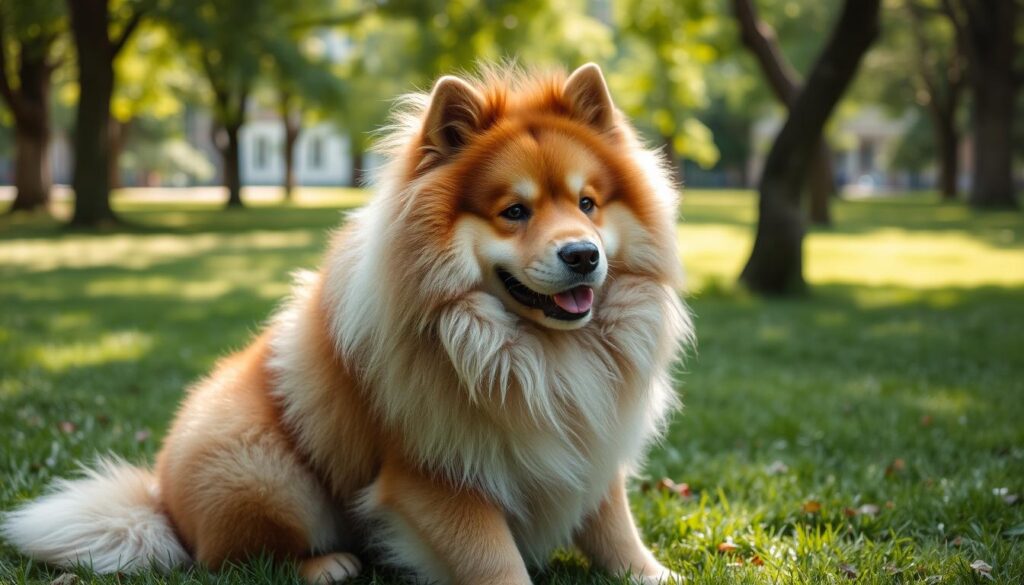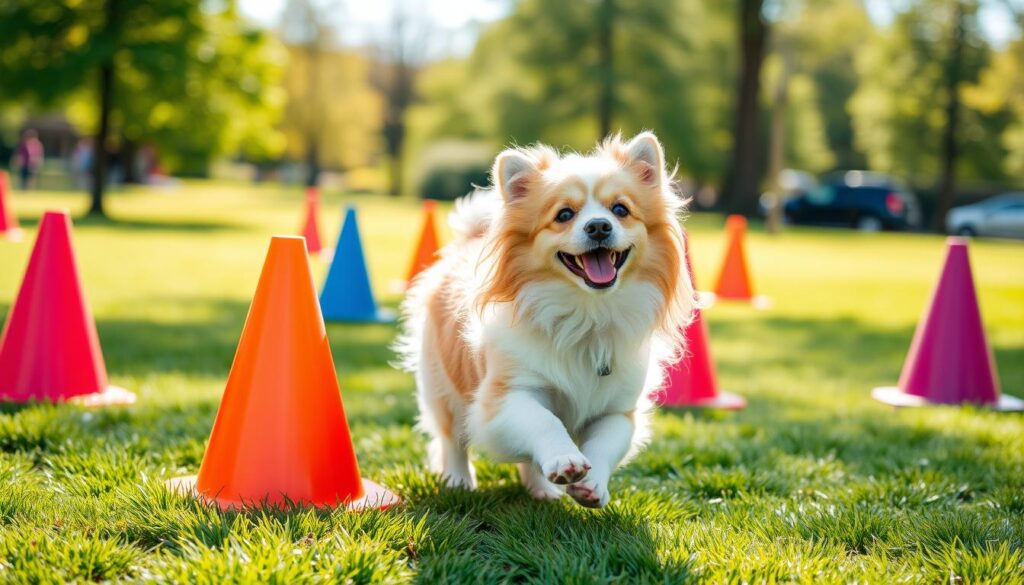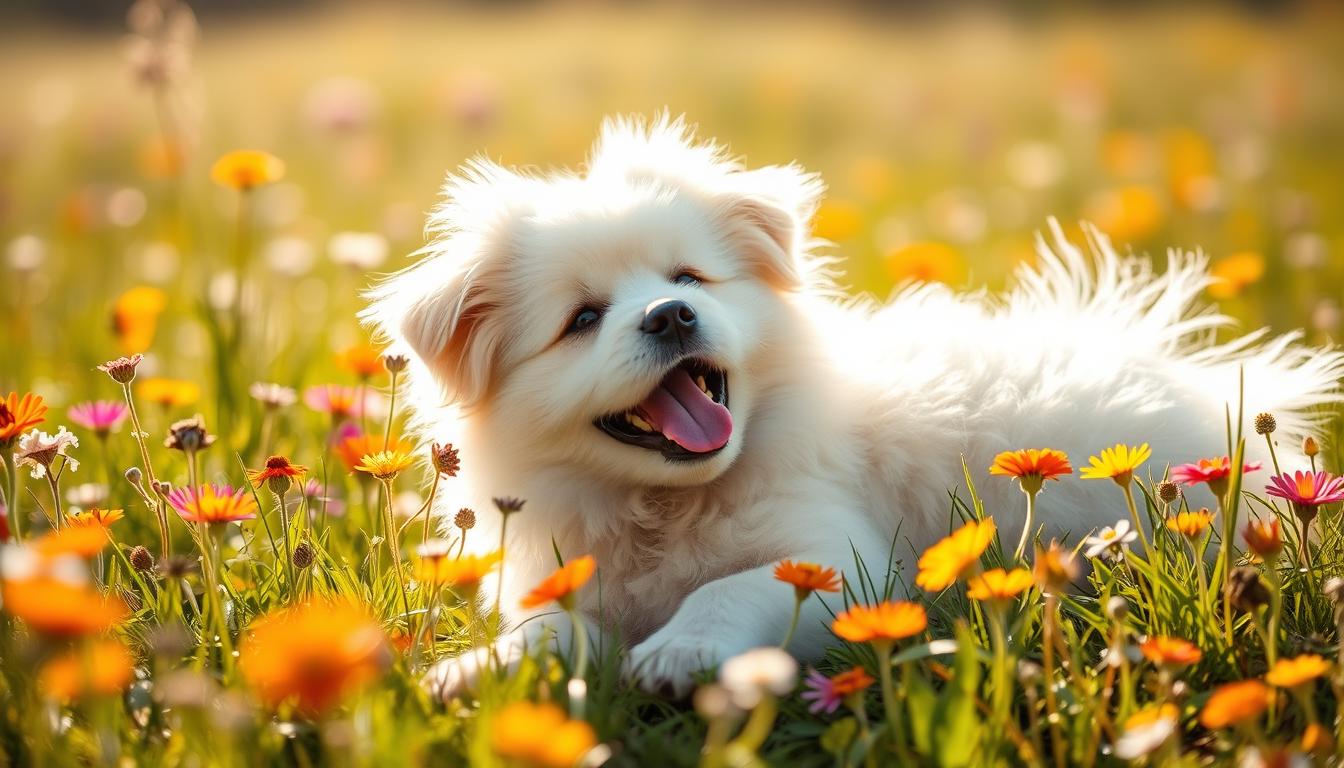Looking for the ultimate fluffy dog companion? This guide is for you! We’ll help you find the perfect furry friend for your lifestyle. Whether you love a big Samoyed or a cuddly Poodle, we’ve got you covered. We’ll cover breeds, grooming, and care tips to find your match.
Fluffy dogs come in all shapes and sizes, each with their own personality and needs. From the majestic Bernese Mountain Dog to the playful Bichon Frise, there’s a lot to explore. We’ll look into what makes a coat fluffy, different coat types, and how to keep your dog looking great.
Key Takeaways
- Discover the ideal fluffy dog breed for your lifestyle and home environment
- Understand the unique grooming needs and shedding patterns of different coat types
- Explore popular big, medium, and small fluffy dog breeds suitable for families
- Learn about the health considerations and essential grooming techniques for fluffy dogs
- Gain insights into the cost of owning and caring for a fluffy canine companion
Understanding What Makes a Dog Fluffy: Coat Types and Characteristics
Looking for a fluffy dog? It’s key to know about coat types and grooming needs. Each dog, from double-coated to single-coated, has its own special traits.
Double Coat vs Single Coat Dogs
Dogs with double coats, like Samoyeds and Bernese Mountain Dogs, have thick undercoats and long outer coats. They need regular grooming to stay fluffy and prevent mats.
Single-coated dogs, such as Poodles and Bichon Frises, have soft, curly fur that sheds less. They might not be as fluffy as double-coated breeds but need less grooming.
Grooming Requirements for Different Coat Types
Keeping your dog fluffy is crucial, no matter their coat. Double-coated dogs need brushing and grooming every 4-8 weeks. Single-coated breeds groom less often but still need regular brushing and trims.
Seasonal Shedding Patterns
Fluffy dogs shed more in spring and fall. This helps them adjust to changing temperatures. Be ready for fur everywhere with the right grooming tools.
Knowing your dog’s coat is the first step to caring for them. With the right grooming and seasonal care, your dog will stay healthy and happy.
Popular Big Fluffy Dog Breeds for Families
Looking for a cuddly, loving pet for your family? Check out these big fluffy dog breeds. They have beautiful coats and are very gentle. This makes them great for homes with kids.
The Bernese Mountain Dog is a classic choice. They have beautiful tri-color coats and are very loyal. They love active families and need lots of space. The Great Pyrenees is also popular. They are smart and make great family guardians and outdoor friends.
If you want a big fluffy white dog, the Samoyed is perfect. They are happy, energetic, and have beautiful coats. The Old English Sheepdog is another great choice. They have shaggy coats and are very gentle, fitting well into many homes.
- Bernese Mountain Dog
- Great Pyrenees
- Samoyed
- Old English Sheepdog
Choosing a big fluffy dog breed means thinking about their needs. They need exercise, grooming, and space. With the right care, they will bring joy and companionship to your home.
Small and Medium Fluffy Dog Breeds
Small and medium fluffy dogs are just as charming as their larger counterparts. They are perfect for living in apartments and are easy to care for. Find out which small and medium fluffy dog breeds are great for different homes and lifestyles.
Apartment-Friendly Fluffy Breeds
Looking for a fluffy dog for your apartment? The Poodle, Bichon Frise, and Havanese are great choices. These dogs are small, don’t shed much, and are friendly. They need regular exercise and grooming to be happy indoors.
Low-Maintenance Fluffy Companions
Want a fluffy dog that’s easy to care for? The Maltese and Shih Tzu are perfect. They have long, silky coats that need less grooming. They are also laid-back and love to be near their owners, making them great companions.
Best Breeds for First-Time Owners
First-time dog owners should consider the Cavalier King Charles Spaniel or Miniature Schnauzer. These dogs are easy to get along with, loving, and eager to please. They are perfect for new dog owners who want a fluffy friend.
“The best fluffy dog breed for you is the one that fits your lifestyle and living situation. Whether you prefer a compact apartment companion or a low-maintenance fluffy friend, there’s a perfect small or medium-sized pup out there waiting to join your family.”
Health Considerations for Fluffy Dogs
Having a big fluffy dog or any fluffy breed comes with special health needs. Their thick coats can lead to skin problems and grooming issues. It’s important to watch for these and take care of them.
Fluffy dogs can easily get too hot because of their thick fur. In warm weather, they might struggle to cool down. To keep them safe, groom them regularly, give them shade, and make sure they have cool water.
Fluffy dogs often face skin issues like allergies and yeast infections. Their fur can hold moisture, making it hard for their skin to breathe. Keeping their fur clean, using the right shampoos, and treating any skin problems quickly is key to their health.
Some fluffy breeds are more likely to get certain diseases. For example, Bernese Mountain Dogs might get cancer, and Poodles could have hip problems. Knowing these risks helps you prepare for your fluffy dog’s health needs.
“Regular check-ups with your veterinarian are essential to catch any health issues early and ensure your fluffy dog remains in optimal condition.”
Looking after your fluffy dog’s health is crucial for their well-being. Regular vet visits, a healthy diet, and good grooming can help them stay happy and healthy.

| Fluffy Dog Breed | Common Health Concerns | Preventive Measures |
|---|---|---|
| Samoyed | Skin allergies, eye problems, hip and elbow dysplasia | Regular grooming, monitoring for skin irritations, joint supplements |
| Golden Retriever | Cancer, hip and elbow dysplasia, exercise-induced collapse | Routine vet check-ups, a balanced diet, moderate exercise |
| Chow Chow | Thyroid issues, hip and elbow dysplasia, bloat | Careful feeding practices, joint support supplements, monitoring for signs of bloat |
Essential Grooming Tools and Techniques
Keeping your fluffy dog’s coat looking great needs the right tools and techniques. You can choose professional grooming or do it at home. Knowing the basics is key to keeping your big fluffy dog looking their best.
Professional vs. Home Grooming
Professional groomers have the skills and tools for a top-notch grooming session. But, grooming at home can save money and bond with your dog. Think about your budget, your dog’s personality, and how often they need grooming to pick the best option.
Seasonal Grooming Tips
The seasons change, and so does your dog’s coat. Adjust your grooming to handle spring shedding and winter prep. Brushing, trimming, and bathing regularly keeps your dog’s coat healthy all year.
Managing Shedding and Matting
Fluffy dogs shed and mat, which can be tough to deal with. Get good brushes, combs, and dematting tools. Stick to a grooming schedule and be gentle when dealing with tangles or mats.
Learning the right grooming tools and techniques helps keep your fluffy dog’s coat in great shape. This reduces shedding and matting. A well-groomed fluffy dog is a joy to have and a healthy, happy friend.
Living with a Fluffy Dog: Maintenance and Care
Owning a big, fluffy dog is rewarding but comes with challenges. You’ll need to manage shedding and keep your home clean. With the right plan, your fluffy dog big breed friend will thrive in your home.
When you have a big fluffy dog rescue, grooming is key. They shed a lot, so brushing and bathing are crucial. Use quality grooming tools to handle their fur.
- Brush your fluffy dog a few times a week to remove loose hair and prevent matting.
- Schedule professional grooming appointments every 4-8 weeks to maintain your dog’s coat.
- Vacuum frequently to stay on top of shedding, and consider using a lint roller on furniture.
Fluffy dog big breed friends need more exercise. They love daily walks, playtime, and mental challenges. Keep them active with games like fetch or agility training.
“Fluffy dogs are a joy to own, but their care takes commitment. Embrace the extra grooming and exercise needed to keep your furry friend happy and healthy.”
Living with a big fluffy dog rescue is rewarding with the right care. Focus on grooming, exercise, and overall care. This way, your fluffy friend will be happy and well-adjusted in your home.
Climate Considerations for Fluffy Dog Breeds
As a big fluffy white dog or big white dog owner, it’s key to know how their coat and size affect their climate adaptability. Whether you live in a cold area or a hot, humid one, making smart choices about their living space and care is vital. This ensures their health and comfort.
Cold Weather Adaptability
Fluffy dog breeds have thick coats that keep them warm in cold weather. But, they can still face risks like frostbite and hypothermia from too much cold. To keep your big fluffy white dog or big white dog warm in winter, dress them in a cozy coat or sweater. Also, limit their time outside when it’s very cold.
Managing Your Dog in Hot Weather
The same thick coat that keeps them warm in cold can be a problem in hot weather. Fluffy dogs can easily overheat and struggle to cool down. Make sure they have shade, fresh water, and air conditioning or cooling mats to stay cool. Avoid hard exercise when it’s very hot and consider cutting their coat short for summer.
Indoor vs Outdoor Living
Fluffy dogs love the outdoors, but their coats and size make them more vulnerable to weather. A comfy, climate-controlled indoor space is usually best for big fluffy white dogs or big white dogs, especially in extreme weather. If they go outside, make sure they have shade and watch for signs of distress.
Understanding climate needs for fluffy dog breeds helps your big fluffy white dog or big white dog thrive anywhere. They’ll enjoy a healthy, comfortable life with you.
Training and Exercise Needs of Fluffy Dogs
Owning a fluffy dog, big or small, needs a lot of effort in training and exercise. These dogs may look cute, but they have lots of energy and strong wills. They need the right way to behave.
Training is key for fluffy dogs. It sets rules, teaches good habits, and strengthens your bond. Begin with simple commands like sit, stay, and come. Then, move on to more complex tricks and social skills.
- Positive reinforcement training, using treats and praise, is the most effective approach for fluffy dogs.
- Consistent training sessions, even for just a few minutes a day, can make a significant difference in your fluffy dog’s responsiveness and overall behavior.
- Enrolling in group training classes or working with a professional dog trainer can also be highly beneficial, especially for first-time fluffy dog owners.
Fluffy dogs also need lots of physical activity to stay healthy and joyful. Without enough exercise, they might get destructive, anxious, or bored.
- Aim for at least 30-60 minutes of daily exercise, such as brisk walks, playtime at the park, or games of fetch.
- Consider activities that tap into your fluffy dog’s natural instincts, like agility courses or herding exercises.
- Provide plenty of interactive toys and puzzles to keep your fluffy companion mentally stimulated when they’re not actively exercising.
By spending time on training and exercise, your fluffy dog will grow into a well-behaved, healthy, and happy friend. With the right care, they’ll become a beloved family member.

Cost of Owning a Fluffy Dog
Getting a big fluffy dog or a fluffy white dog is exciting. But, it’s key to know the financial side. The costs can add up fast, from the start to ongoing expenses and health care.
Initial Costs and Supplies
The first costs of getting a fluffy dog are big. You’ll need to pay for the dog itself, whether from a shelter or a breeder. You’ll also need to buy important things like a good dog bed, grooming tools, and a strong leash and collar.
Ongoing Expenses and Care
- Regular grooming: Fluffy dogs need a lot of brushing and professional grooming. This can cost $40 to $100 per session.
- Food and treats: Fluffy dogs eat a lot and might need special food, which can be expensive.
- Boarding and dog walking: If you travel or work a lot, boarding or dog walkers can cost a lot.
Insurance and Healthcare Costs
Fluffy dogs might get sick more often, like skin problems or joint issues. Pet insurance can help with vet bills. Also, regular vet visits, shots, and care add to the cost of having a fluffy pet.
| Cost Category | Estimated Range |
|---|---|
| Initial Costs (including supplies) | $500 – $2,000 |
| Monthly Expenses (food, grooming, insurance) | $50 – $200 |
| Annual Veterinary Care | $200 – $1,000 |
Knowing the cost of a fluffy dog helps you plan your budget. This way, you can give your pet the care and love they need.
Conclusion
Fluffy dogs come in many sizes, shapes, and coat types. Each has its own joys and responsibilities. Whether you like big fluffy dogs or smaller ones, the key is finding the right fit for you.
This guide has given you the basics to choose wisely. You learned about grooming needs and how some dogs handle cold weather. Remember, owning a fluffy dog is a big commitment. Think about the costs, expenses, and time needed to keep them happy.
Starting your search for the perfect fluffy dog? Get ready to love and care for your new friend. With the right match, you’ll enjoy years of loyalty, cuddles, and fun.

